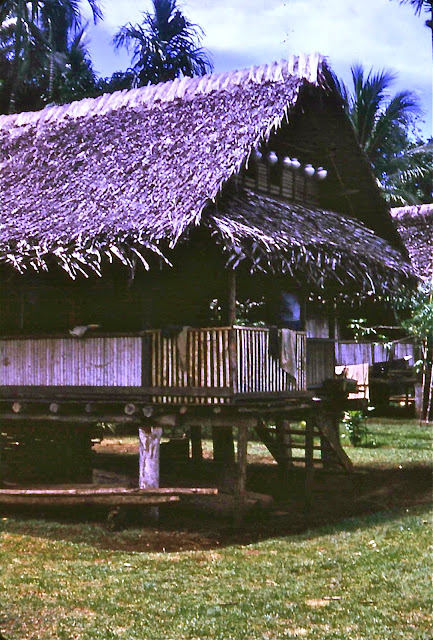If you haven't read the previous couple of posts, I used to live and work in Papua New Guinea between 1967 and 1970. I was frequently flying between towns and consequently saw a lot of this fascinating country.
While staying in Madang, the owner of the motel drove us into the hills where we visited this native village.
 |
| A typical Madang house |
As soon as we arrived, the picanninis (children), came to check us out. The villagers were very friendly and always welcomed visitors.
 |
| The Village Square with the local kids |
The men were out hunting gathering and left the womenfolk to look after the villages. The women were pottering, producing ware they would take to the local markets to sell,
 |
| This woman is finishing a pot |
Of course, they also looked after the children and small farming animals such as pigs and chickens.
 |
| Mum with her two children |
In Manus Island, we worked in the Australian navy base, 'HMAS Tarangau'. We were building the communications building. I employed a young boy by the name of Pius, to help me with the electrical installation. He had just left school and was looking for work. He was a good worker and willing to learn. He showed me how to get coconuts straight out of a tree, by climbing up without ropes or ladders.
 |
| Pius is picking a coconut |
In Wewak, in the Sepik District, we played soccer on the beach on a Sunday and before long, the local kids joined us in the fun. The kid standing in front of me is wearing my sunnies.
 |
| On a beach with the local children |
Also on a beach in Wewak, I took a picture of this woman carrying her shopping home in typical New Guinea fashion with a net carried with her head.
 |
| A woman carrying her goods. |
It is such a shame that the people in Papua New Guinea can't get their act together. It could be a fantastic tourist destination for people around the world. Instead, the country is dominated by corruption and fighting and today is one of the most dangerous places to live. I am so happy, it was paradise in the 60s when we lived there.